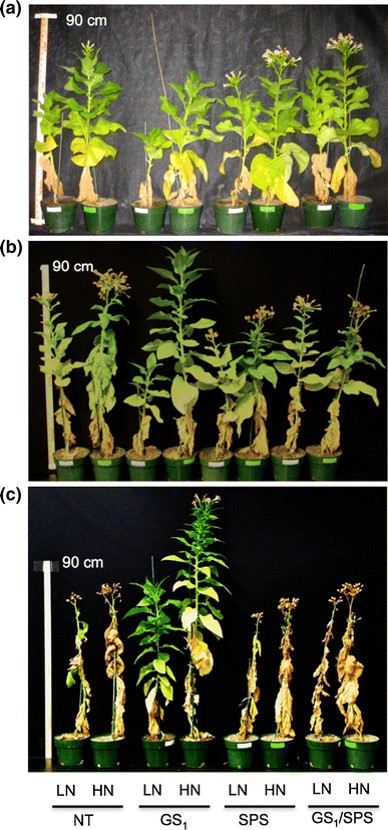Abstract
Main conclusion The outcome of simultaneously increasing SPS and GS activities in transgenic tobacco, suggests that sucrose is the major determinant of growth and development, and is not affected by changes in N assimilation.
Carbon (C) and nitrogen (N) are the major components required for plant growth and the metabolic pathways for C and N assimilation are very closely interlinked. Maintaining an appropriate balance or ratio of sugar to nitrogen metabolites in the cell, is important for the regulation of plant growth and development. To understand
how C and N metabolism interact, we manipulated the expression of key genes in C and N metabolism individually and concurrently and checked for the repercussions.
Transgenic tobacco plants with a cytosolic soybean glutamine synthetase (GS1) gene and a sucrose phosphate synthase (SPS) gene from maize, both driven by the CaMV
35S promoter were produced. Co-transformants, with both the transgenes were produced by sexual crosses. While GS is the key enzyme in N assimilation, involved in the synthesis of glutamine, SPS plays a key role in C metabolism by catalyzing the synthesis of sucrose. Moreover, to check if nitrate has any role in this interaction, the plants were grown under both low and high nitrogen. The SPS enzyme activity in the SPS and SPS/GS1 co-transformants were the same under both nitrogen regimens. However, the GS activity was lower in the co-transformants compared to the GS1 transformants, specifically under low nitrogen conditions. The GS1/SPS transformants showed a phenotype similar to the SPS transformants, suggesting that sucrose is the major determinant of growth and development in tobacco, and its effect is only marginally affected by increased N assimilation. Sucrose may be functioning in a metabolic capacity or as a signaling molecule.


